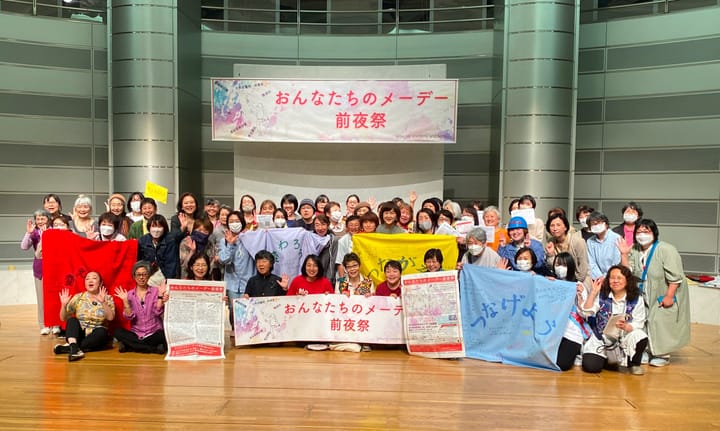Technology and Labor’s role in Climate Action and Justice: -Part Ⅱ-

※Part Ⅰ is available, here.
Toshiyo Hibino There are two reasons why Japan must tackle climate change. First, it has a responsibility as an industrialized country that historically used a large amount of fossil fuels. Secondly, Japan’s per capita emissions are higher than those of China and India, both of which use more fossil fuels. It was thought that the effects of climate change would not impact developed countries until much later, but things are happening so rapidly that the damage is no longer limited to developing countries.
Developed countries need to talk about curbing the causes of climate change and addressing the actual damage that is caused in the same political discourse.
As a developed nation, Japan needs policies that will force change in sectors that emit the most CO2; steel and thermal power generation, where more than half of Japan’s CO2 emissions come from.
Oates The United Nations Framework Convention on Climate Change (UNFCC) is trying to get the world to stop using coal and oil and start using renewable energy. However, it is only strangling the developed countries. Many people around the world will suffer from fuel shortages again this winter, but what is the point? Oil is easy to transport and use, so no one will ever completely stop using it. It can be stored. Instead, we are cutting down forest after forest, filling up valleys with solar panels and using wind power to generate electricity. The electricity produced in this way destroys nature and cannot be stored. It will only cost more in the long run.
Because the government can propose such a project, the cost of power generation can be added to the electricity bills of households in the name of “responsibility of the beneficiaries of the electricity.” A TV anchor has said to Prime Minister Kishida Fumio, who attended COP26 in Glasgow, Scotland, “I hope you will make an ambitious statement,” but it is the people who will bear the cost.
Hibino In terms of cost reduction, the key point is how much we can lower the fees (transmission fees) for new power companies to use the transmission lines owned by existing power companies. For example, the current low price of coal is keeping the cost of coal-fired power generation low. If we switch to small-scale power generation distributed by new power companies, the cost of electricity is likely to rise. The poorer the household, the greater the burden. We need to think up ways to lower transmission charges.
Relying on unknown technology
When the then-US President George W. Bush withdrew from the Kyoto Protocol in 2001, he said, “there will be great technology in the future that will reduce CO2 emissions.” This is a clear mistake. The temperature is going to rise at an accelerated rate. Even if we can build a car in the future that emits almost no CO2, we will not be able to lower the temperature that has already risen.
Japan is no stranger to not thinking about an issue. Prime Minister Kishida says that Japan will be carbon neutral by 2025, but there is no vision in the next five or 10 years about how we will get there.
Oates Japan is obsessed with developing technology to capture CO2 emitted from thermal power plants. The technology was originally developed in the US for use in oil extraction, and an affiliated organization of the Ministry of Economy, Trade and Industry (METI) took the lead in conducting demonstration tests.
The technology to bury CO2 underground is called CCS (Carbon, Capture and Storage). METI has been trying to put CCS to practical use as a promising technology for more than 10 years. It is based on an established technology as a method of mining underground resources.
Shale oil (gas) is being mined in the US, where the oil is squeezed out of the ground by pushing a medium (mud). This is why new wells need to be dug one after another, resulting in significant environmental destruction. If we use it as a medium for shale oil extraction, we can kill two birds with one stone by processing CO2 and extracting oil at the same time. But how do we separate CO2 into liquid form? It is safer to consider other processing methods.
In my opinion, there are many irrational claims in the new catchphrase, “carbon neutral.” In Japan, there was an oil shock in the 1970s, and since then, there has been a thorough effort to save energy. In fact, Japan’s energy consumption has been kept low compared to Europe, China and the US.
Investing in energy conservation to lower Japan’s energy consumption will lead to cost savings, resulting in real benefits. The government should encourage capital investment that makes emissions cleaner. even if it costs a lot. However, COP’s sole focus on CO2 emissions is simply a prerogative. Aiming for the “real” zero emission and reducing the emissions do not mean the same, and is impossible to achieve.
We all know that better insulation of houses is the most effective way to save energy. Instead of doing so, however, the government is trying to promote storing CO2 in the ground based on the estimation that CO2 emissions could be negative. This should be criticized.
Hibino Where are the reservoirs to bury CO2 in earthquake-prone Japan? There are virtually no examples of this being achieved in the world.
In regions other than Hokkaido, there has been little progress in insulating houses. Why hasn’t progress been made compared to Europe and the US? It is not that the major Japanese housing companies (Panasonic, Daiwa House, etc.) do not have the power to do this. However, the Japanese government only focuses on the “latest technology” with unknown effects. They are trying to find a way to make a living in the energy, automobile and power generation industries.
Oates This kind of technology is subsidized and operates on a large scale. They only pick up what stands out and reluctantly take up the time-consuming work of insulating houses. They only focus on projects that make them look good, regardless of the actual effect.
Hibino Electricity consumption in households can be reduced by simply making houses more insulated. The durability period of Japanese houses is also too short. The argument for improving the thermal efficiency of houses has been around for more than 20 years, but there has been no progress. It will be difficult to achieve this unless subsidies are provided or a system is designed to make insulation mandatory.
Excuses of Keidanren Business Federation
Since 1997, Keidanren (Japan Business Federation) has been saying that Japan’s energy efficiency is so advanced that it cannot do any better. However, while they have been saying that, Japan has been overtaken by other countries. It stopped developing further technology after the introduction of hybrid cars. Although it has maintained coal-fired power generation as a national policy, it is the target of criticism globally.
Since 2012, coal-fired power plants are no longer required to have a permit and can be installed if they pass only an environmental assessment. Since new nuclear power plants can no longer be built, there are more than 20 coal-fired power plants planned for construction. The biggest problem is that it will take about 40 years to make the plant profitable, even after taking depreciation into account. In the meantime, it will continue to emit smoke and is no different to a nuclear power plant. The EU would look at Japan critically because we are letting this happen.
Locally produced, electricity by distributed power sources
Oates It is clear that replacing current energy sources with new ones will cost more. The only way to deal with this is to; 1) save more energy, 2) increase the burden of the public, and 3) increase taxes. However, we are talking on the premise that we would generate “renewable energy.”
In Japan, electricity prices doubled after the Great East Japan Earthquake, and this was due to the added cost of dealing with the nuclear accident. I think the government is trying to use it as an excuse to force a further price hike on the market.
Japanese media have not reported enough on the background of the ever-increasing cost of electricity. Some trade magazines cover the utilities industry, but not the pros and cons of nuclear power.
There are still improvements that can be made to the systems of the power companies. I would like to point out that decentralizing power plants and creating small ones closer to where electricity is consumed will save energy. Instead of bringing the electricity from Fukushima to Tokyo, we can save energy by simply generating electricity in Tokyo for local consumption.
The current method of using high-voltage power lines to transmit electricity over long distances is wasteful. There are still vestiges of the pre-war power control system. If we can establish the same power lines across the country, which currently vary among the utility companies, it will effectively distribute energy.
Hibino There are areas suitable for offshore wind power and other renewable energy sources. Hokkaido and the Sea of Japan side of Tohoku are actively trying to attract them. The challenge is to reduce the cost of the power grid that carries the power generated in these areas. What is preventing this is the current preferential treatment given to existing power companies. They are also the destination for METI officials. The reality is that people and money are flowing back into the system.
Oates Japan relies almost all on imports in terms of coal, oil and liquefied natural gas (LNG) and the cost is estimated at around 17 trillion yen(※) in 2019, shortly before the pandemic hit. The Japanese people pay their share. Japan will continue to pay for these imports for the foreseeable future, but the cost of imports will decrease as the amount used decreases. As the population declines, the cost of imports will gradually increase, but the investment to reduce the amount used should be considered a recoverable cost.
No one talks about ‘climate justice’ in Japan
Hibino In Japan, there is an unfounded hope that someday great technology will be developed and problems will be solved. There is also a side of Japan that does not want to shift to new technologies, despite the fact that it has excellent technologies such as micro power generation.
At COP26, young people and activists from around the world rallied in Glasgow to advocate for ‘climate justice,’ a view that seeks to redress the injustices of global warming that are more devastating to the economically vulnerable and younger generations who bear little responsibility for it.
In Japan, this is a secondary concern. Given the magnitude and speed of climate change, industries also have to change. Rather than prolonging the life of the coal industry with subsidies, they should explore ways to cope with the changes by listening to the opinions of the people involved at an early stage. It is the role of politics to decide the policy.
For more than 20 years, Japanese politicians have been saying, “Japan is making progress in energy conservation, and it will be difficult to go any further.” So far they have done nothing. In the meantime, the efforts of other countries around the world have advanced. There is an urgent need to update our awareness.
Labor unions key to advocating for just policies
We must think about the workers and how they are influenced by the shift.
In 1996, when a coal mine closed in Chikuho region, Fukuoka Prefecture, workers lost their jobs. The transfer of workforce between the industries ended in failure. Workers’ livelihood and well-being deteriorated. We must also think about what other prospects to offer to the engineers and workers.
The international pressure to close down fossil fuel plants will increase, as a measure to combat climate change, in the future.
Labor unions also need to think about adapting to the changes, including occupational mobility, or the results will be disastrous. The International Energy Agency (IEA) has calculated that job creation from renewable energy and energy conservation is greater than from fossil fuel and nuclear power projects.
Labor unions are also responsible in the sense that they are not in touch with climate justice. The first victims of climate change will be the poor and the vulnerable. Since it is the workers who will be affected, unions must also address this. Labor union think tanks should advocate policies that broaden the idea of climate change.
(※) The imports were estimated at 21 trillion yen in the 2018 White Paper on the Environment (2017), and in 2019 they were estimated at around 17 trillion yen. The amount is expected to soar after 2022 due to weaker yen.


